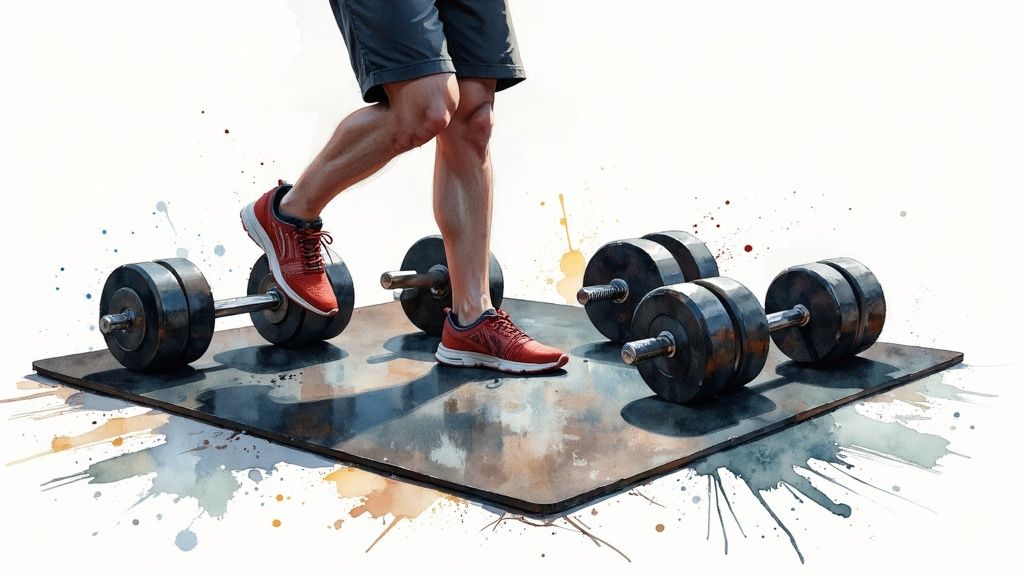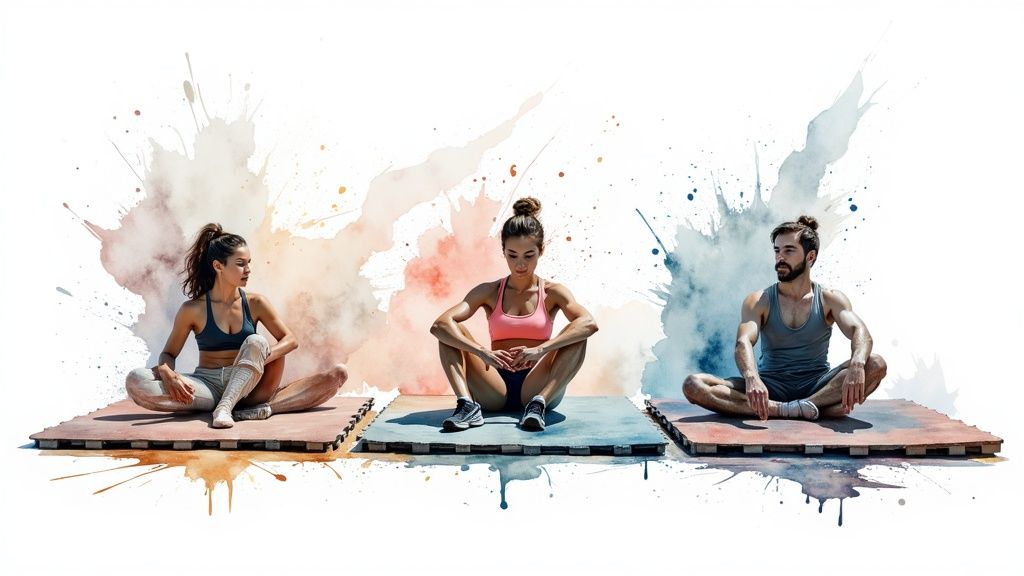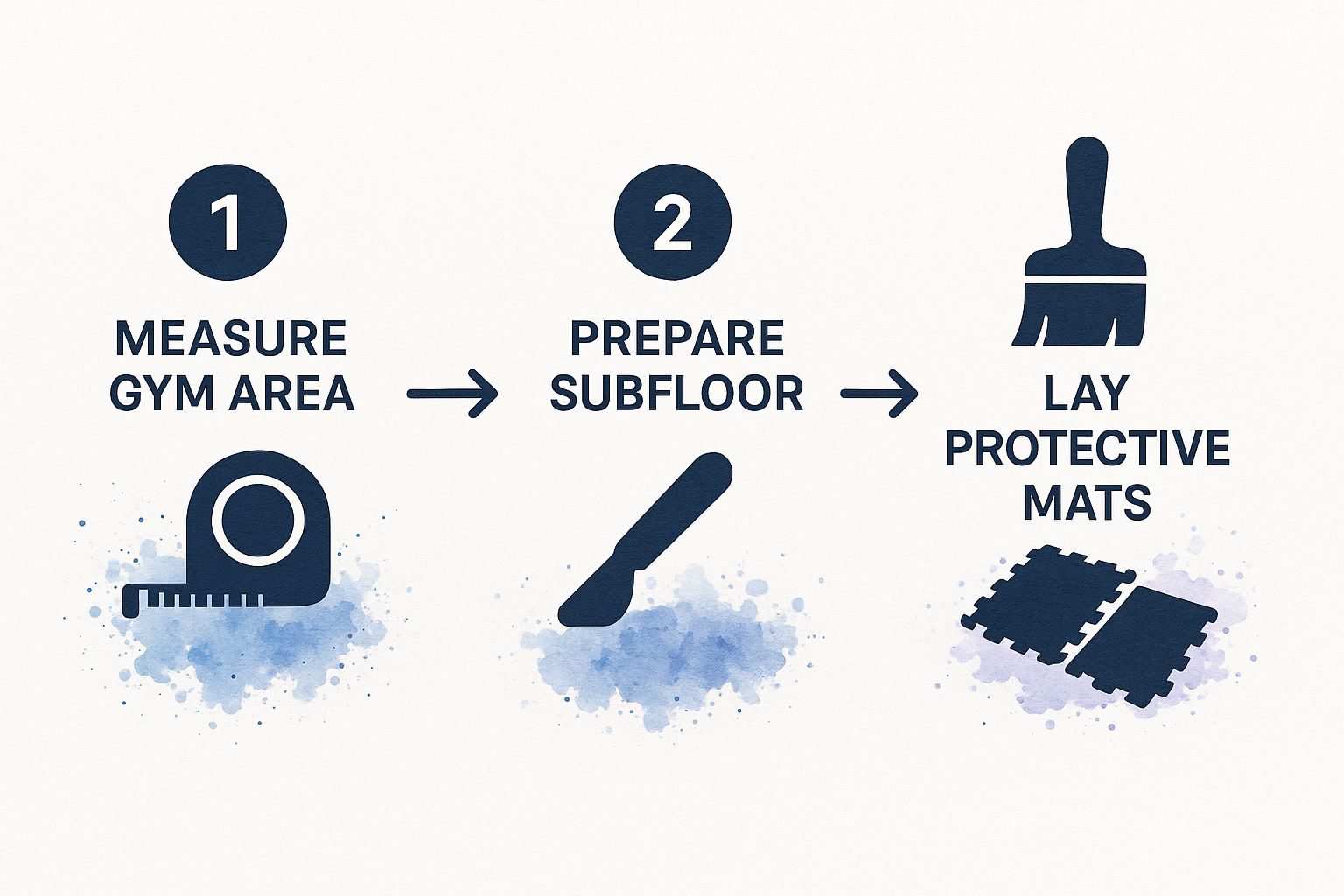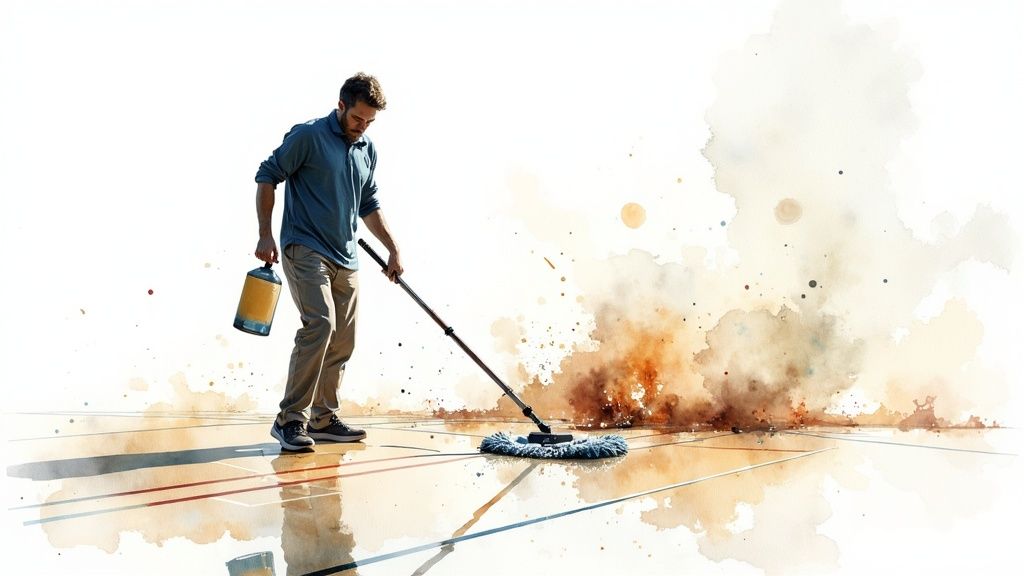Let's be honest: your gym floor takes a beating. It’s the single most valuable and abused asset in your entire facility. Thinking about gym floor protection as just another expense is a mistake. It’s a foundational investment that protects your members, your equipment, and your business's future.
From the thud of a dropped dumbbell to the constant scuff of high-traffic classes, a proper protection strategy is non-negotiable if you want your floor to last. This guide provides actionable steps to select, install, and maintain the right flooring to safeguard your investment.
Your Foundation for a Safer and More Durable Gym

Think of your gym floor as the silent partner in every single workout. It has to endure constant stress from heavy squat racks, intense cardio sessions, and the relentless impact of free weights. Without a tough protective layer, your subfloor—whether it’s concrete, wood, or vinyl—is completely exposed to cracks, dents, and the kind of expensive structural damage that can shut your doors for repairs.
This is where you can shift your mindset from reactive to proactive. Instead of budgeting for fixing damage, you can implement a strategy to prevent it. The benefits go way beyond aesthetics.
- Boost Member Safety: The right surface provides critical shock absorption, which is easier on your members' joints and drastically reduces the risk of slips and falls. This directly impacts your liability and member confidence.
- Slash Operational Costs: Preventing floor damage means you avoid massive repair or replacement bills. For example, replacing a cracked concrete subfloor can cost thousands, money that could be reinvested into new equipment or marketing.
- Improve Gym Acoustics: Clanging weights are loud. Thick rubber flooring dampens that noise, creating a more focused and pleasant environment for everyone. This benefit is especially crucial in multi-zone facilities where a quiet yoga class might be next to a busy weight room.
- Sharpen Your Professional Image: A clean, well-maintained floor tells members you care about quality and safety. It’s a small detail that has a huge impact on member retention and attracting new clients.
The Growing Demand for Quality Flooring
The fitness industry is catching on. We're seeing huge growth in the market for specialized flooring because owners understand the payoff. In fact, the global rubber gym floor mat market is expected to hit $500 million in 2025 and is projected to grow at a 7% compound annual rate through 2033. This isn't just a trend; it's a direct response from gyms wanting to create safer spaces and reduce injury risks.
The right flooring does more than protect a surface; it protects people, equipment, and your bottom line. It is the groundwork for a successful and safe fitness environment.
For instance, a commercial gym specializing in powerlifting needs thick, high-impact rubber tiles that can handle repeated 400-pound deadlift drops without flinching. This prevents costly subfloor cracking. In contrast, a boutique studio focused on yoga and HIIT classes is better served by versatile rolled rubber, which provides the comfort and durability needed for bodyweight exercises and light equipment without the extreme thickness.
For even more demanding industrial or commercial settings, you can check out our guide on heavy-duty floor protection to see how these principles apply on an even larger scale. Each choice is a deliberate investment tailored to that facility's unique day-to-day operations.
Choosing the Right Gym Floor Protection

When it comes to gym floor protection, it's easy to get bogged down by looks or price. However, a smart investment comes from matching the flooring directly to the real-world activities happening in your space. Choosing incorrectly leads to premature wear, safety hazards, and a bigger bill down the line.
Before you look at a single sample, perform a simple audit of your facility. Are you all about dropping heavy barbells during Olympic lifts, or is your space filled with the constant motion of high-energy cardio classes? The demands are worlds apart, and your floor protection needs to be up for the challenge.
How to Match the Material to the Activity
The single most important decision you'll make is matching the material's impact resistance to your gym's function. Here’s a practical breakdown of how to choose based on common gym types:
-
For CrossFit Boxes or Powerlifting Gyms: The activity involves heavy, concentrated weights dropping repeatedly. Standard flooring will fail.
- Actionable Strategy: Choose thick, high-density rubber tiles, specifically 3/4-inch (19mm) or thicker. This is the only material that will reliably absorb the shock from a 400-pound deadlift and protect the concrete underneath.
-
For Commercial Fitness Centers: These gyms are often a mix of different zones.
- Actionable Strategy: In the free weight area, install 3/8-inch (9.5mm) rubber rolls or tiles to protect against dropped dumbbells. In cardio and group fitness areas, switch to 1/4-inch (6mm) rubber or durable vinyl to balance comfort, durability, and cost.
-
For Yoga or Pilates Studios: The priority shifts from high-impact resistance to user comfort and hygiene.
- Actionable Strategy: Select a softer, less dense material like premium vinyl or specialized foam matting. This provides a comfortable surface for floor work and is non-porous, making it easy to clean and sanitize between classes.
Key Factors Beyond Impact Resistance
Beyond specific exercises, a few other crucial factors come into play. Overlooking these can lead to maintenance headaches and a poor member experience.
First, identify your subfloor. Are you laying your new flooring over concrete, wood, or existing tile? Some rubber products can react with and stain polyurethane-finished hardwood, so you might need a specific underlayment. A quick check of the product specifications can prevent a massive refinishing bill.
A common mistake is overlooking acoustics. A bustling weight room can be incredibly loud, but the right flooring can significantly dampen noise. Dense rubber is excellent at absorbing sound, creating a more pleasant and focused atmosphere for all your members.
Finally, be realistic about your maintenance routine.
- Benefit of Rolled Rubber: Creates a nearly seamless surface, minimizing crevices where dirt and grime can hide. This is ideal for facilities aiming for quick, efficient cleaning.
- Benefit of Interlocking Tiles: If a tile gets damaged, you can simply pop it out and replace it individually, saving you the cost and hassle of redoing an entire area.
A Practical Guide to Installing Your Gym Flooring
Proper installation is just as critical as the product itself—a botched job can void warranties and create nasty tripping hazards. When you get the installation of your gym floor protection right, you're locking in all the benefits of safety, durability, and a professional look.
A bad installation is one of the top reasons for premature flooring failure. Even the best materials won't perform well if they aren't laid correctly. The good news? With a bit of planning, you can get a flawless finish.
Setting Yourself Up for Success
Before you lay down the first tile or roll, you must prep your space. A clean, level, and dry subfloor is the absolute foundation for a successful installation. Rushing this step guarantees future problems like bumps, uneven surfaces, or poor adhesion.
This simple visual breaks down the core steps for any gym flooring project.

As you can see, a great installation comes down to three things: measuring precisely, preparing the subfloor thoroughly, and placing your protective mats with care.
Here’s another crucial tip: let your flooring acclimate. Materials like rubber and vinyl expand or contract with temperature changes.
- Actionable Step: Let the flooring material sit in the installation room for at least 24-48 hours before you start. This allows it to adjust to the room's ambient temperature and humidity, which prevents buckling or gapping later on.
Mastering Installation Techniques
The right technique depends on the material you've chosen. For interlocking tiles, a common mistake is starting right against a wall. Walls are rarely perfectly straight, which can throw off your entire grid.
How-To Tip: Find the center of your room and snap chalk lines to create four quadrants. Begin laying your tiles from this center point and work your way outward. This method ensures your pattern stays straight and symmetrical, giving you a clean, professional look.
With rolled rubber, the biggest challenge is creating invisible seams.
- Actionable Step: After unrolling the flooring and making your cuts, apply a specialized seam adhesive or double-sided mat tape designed for rubber along the edge of one roll. Then, butt the next roll up against it as tightly as possible. This prevents the edges from curling up over time—a common and dangerous tripping hazard. Our guide on floor safety mats offers more insights into preventing these issues.
One final, critical piece of advice: leave a small expansion gap (about 1/4-inch) around the perimeter of the room. This space allows the flooring to expand and contract naturally without buckling against the walls, ensuring the long-term stability of your gym floor protection.
Turning Your Gym into a Multi-Purpose Venue
Your gym is more than a court—it’s a valuable, versatile space. With the right approach, it can host everything from graduations and trade shows to concerts and community fairs. But this versatility brings a major challenge: protecting your expensive athletic flooring from the wear and tear of non-sporting events.
Good gym floor protection turns this risk into a revenue-generating opportunity. The key is to choose the right temporary solution for each specific event.
How to Match the Cover to the Event
There's no single "best" gym floor cover. The right choice depends entirely on what you're hosting. A high school robotics competition with heavy, rolling carts needs a completely different type of protection than a formal donor gala.
Let's walk through a real-world scenario. Imagine your community center is renting out its basketball court for a weekend craft fair. You're expecting thousands of visitors, and vendors will be setting up heavy tables and displays.
In this case, heavy-duty polypropylene modular tiles are a fantastic choice. Here’s how they provide a direct benefit:
- Benefit (Durability): They can handle the weight of tables, equipment, and constant foot traffic without denting or cracking the wood floor underneath.
- Benefit (Efficiency): The snap-together design means a small crew can lay them down and pick them up quickly, minimizing gym downtime and labor costs.
- Benefit (Protection): Any spilled drinks or tracked-in rain won't seep through and warp the valuable wood floor.
This need for adaptable, protective solutions is a major force in facility management. As more gyms become multi-use venues, the demand for high-quality covers has skyrocketed. You can dive deeper into the latest gym floor cover market trends to see what’s driving these decisions globally.
Smart Deployment and Storage
Choosing the right cover is only half the battle; how you handle it matters just as much. For large vinyl or carpet roll covers, specialized mobile storage racks are a game-changer. These racks make deploying the cover a smooth, efficient process and prevent creases and damage when it's stored.
How-To Tip: When laying down a rolled cover, always use a non-marking push broom to smooth out wrinkles and air bubbles as you unroll it. A perfectly flat cover is not only safer for guests but also provides more effective protection for the floor beneath.
After the event, ensure the cover is completely clean and dry before you roll it back up. Trapped moisture can lead to mold and mildew, which can ruin the cover and potentially damage the gym floor itself. A quick sweep and spot-clean after every use is a simple discipline that ensures your gym floor protection system is ready for the next event, preserving both the cover and the floor for years.
Your Long-Term Floor Maintenance and Care Plan

Once your gym floor protection is down, the real work begins. Many facility owners invest in a high-performance floor only to watch it degrade due to a lack of a maintenance plan. Consistent care is what keeps your floor safe, professional, and durable.
Think of it as building simple habits that stop minor issues from becoming major, costly problems. Every flooring material has its quirks, but the goal is always the same: stay ahead of dirt, wear, and tear.
Creating Your Cleaning Checklists
A structured cleaning schedule is your best defense. All that chalk dust, sweat, and dirt doesn't just look bad—it acts like sandpaper, slowly breaking down your floor's surface. Here is an actionable checklist you can implement immediately:
- Rubber Flooring (Daily): Sweep, dust mop, or vacuum to pick up loose debris. Pay extra attention to high-traffic zones like the free-weight area and main walkways.
- Vinyl Surfaces (Weekly): Mop with a manufacturer-approved, neutral pH cleaner. Using harsh chemicals can strip the protective top layer over time, leading to dullness and damage.
- Artificial Turf (As Needed): Use a stiff-bristled broom or a purpose-built turf rake to fluff up the fibers and remove debris. This keeps the turf performing correctly for sled pushes and prevents matting.
A critical point for rubber flooring is the type of cleaner you use. It absolutely must be a neutral pH cleaner. Anything too acidic or alkaline will attack the binders holding the rubber together, making it brittle and prone to cracking. This simple choice can add years to your floor's life.
The global demand for high-quality gym flooring is exploding. The market shot past USD 1 billion in 2023 and is on track to grow by over 5% each year through 2030. This isn't just a number; it shows that facility owners everywhere are realizing that a great floor is the foundation of a modern fitness space.
Proactive Repair Strategies for Longevity
Damage will happen. It's a gym, after all. A proactive repair strategy will save you money and prevent unnecessary downtime.
-
Problem: A chunk is taken out of an interlocking rubber tile.
- Solution: Don't replace the whole floor. Use a flathead screwdriver to carefully pry up the single damaged tile and pop in a new one. This is a 10-minute, low-cost fix that keeps your floor looking sharp.
-
Problem: A seam on your rolled rubber flooring starts to lift.
- Solution: Address this immediately. Clean any debris from underneath, apply a specialized seam sealer, and press it down with a heavy weight until it cures. This eliminates a serious tripping hazard.
For a more detailed walkthrough of cleaning methods, check out our guide on how to clean gym mats. This kind of consistent upkeep is what separates a well-run facility from the rest.
Your Top Gym Flooring Questions, Answered
Even with the best plan, you’re bound to have questions. Getting these details ironed out beforehand is key to making a confident decision about your gym floor protection. Here are answers to the most common queries we receive.
Will Rubber Mats Stain My Hardwood Floor?
This is a common concern, especially for multi-purpose venues with basketball courts. The short answer is that it's unlikely with quality products, but it can happen. The issue is a potential chemical reaction between antioxidants in some lower-quality rubber and the polyurethane finish on wood floors, which can cause discoloration.
Luckily, the solution is simple:
- Actionable Tip 1 (Barrier): Lay down a breathable underlayment or a basic plastic vapor barrier. This creates a physical shield, stopping any chemical contact.
- Actionable Tip 2 (Product Choice): Select high-quality, modern rubber flooring specified as "non-staining" and safe for hardwood. Always check the product specs or ask the supplier directly.
How Thick Should My Gym Flooring Be?
This all comes down to impact. The thicker the mat, the more force it can absorb.
For a general fitness area with cardio machines and light to moderate free weights, a 3/8-inch (9.5mm) rubber roll or tile is the industry standard. It provides ample protection for daily traffic and the occasional dropped dumbbell.
However, for dedicated weightlifting zones where heavy barbells are hitting the deck, you must increase the thickness.
Expert Tip: For areas with Olympic lifting and heavy deadlifts, do not use flooring thinner than 3/4-inch (19mm) rubber. This thickness is essential for protecting your subfloor from extreme impacts that can cause serious, expensive structural damage.
Can I Install Gym Flooring on My Own?
Absolutely. Most popular gym floor protection systems today, like interlocking tiles and many rubber rolls, are designed for DIY installation.
The secret to a professional-looking, long-lasting floor isn't the installation itself—it's the prep work.
- How-To Action: Take the time to ensure your subfloor is perfectly clean, completely dry, and level before you lay the first piece. This single step is what separates a professional finish from a sloppy, failure-prone one.
If you’re still weighing your options, our guide on choosing the right anti-slip floor mats offers more great tips for finding safe and durable solutions for any busy part of your facility.
At Mats4U, we live and breathe high-performance flooring. Our focus is on providing tough, reliable solutions that protect your gym and keep your members safe. Take a look at our huge collection of gym mats and flooring to see what works for you. Start exploring at https://www.mats4u.com.







